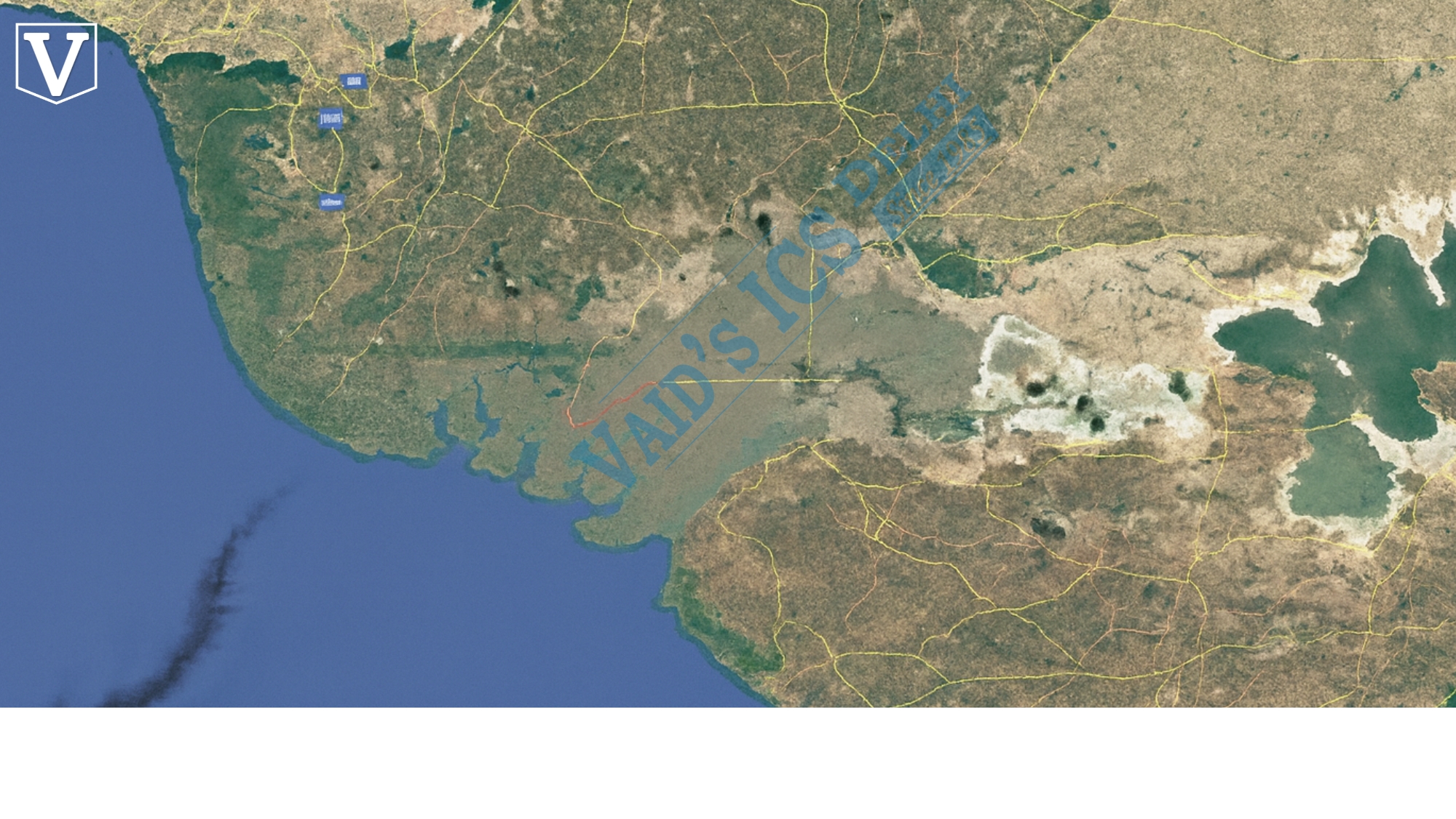Sir Creek: Site of Decades-Long India–Pakistan Border Dispute
Indian Express

Key Arguments
- Background and Definition
○ The Sir Creek dispute involves a 96-km tidal estuary between Gujarat (India) and Sindh (Pakistan).
○ The disagreement centers around the maritime boundary and Exclusive Economic Zone (EEZ) rights derived from it. - Strategic and Economic Significance
○ Sir Creek’s proximity to Karachi, Pakistan’s largest city and naval base, gives it strategic importance.
○ Control over the area impacts fishing rights, offshore oil/gas exploration, and maritime security. - Historical Context and Legal Basis
○ The dispute dates back to colonial demarcations and the 1968 tribunal decisions post the 1965 Indo-Pak war.
○ Core contention lies in applying the Thalweg principle — whether the boundary runs mid-channel (India’s claim) or along the eastern bank (Pakistan’s claim). - Security and Geopolitical Dimensions
○ Continuous militarization and naval patrols have heightened tensions.
○ India accuses Pakistan of using the area as a launchpad for smuggling and drone infiltration.
○ Pakistan views Sir Creek as a strategic buffer zone protecting Karachi’s coastline. - Diplomatic Engagements and Stalemate
○ Since 1989, multiple bilateral talks and technical surveys have been held without a breakthrough.
○ Lack of trust and political will on both sides keeps the dispute unresolved.
Author’s Stance
● Neutral but security-conscious perspective.
● Acknowledges India’s strategic rationale for vigilance and defense preparedness.
● Subtle pro-India leaning, portraying Pakistan’s actions as aggressive and expansionist while maintaining factual tone.
Possible Biases
● Pro-India bias – stronger emphasis on Indian security concerns than Pakistani narratives.
● Frames Pakistan through a defense and terrorism lens rather than exploring its economic rationale.
● Limited mention of international law mechanisms (UNCLOS) or third-party mediation.
Pros
● Provides historical and legal depth (Thalweg principle, 1968 tribunal reference).
● Links strategic, economic, and security dimensions effectively.
● Uses balanced factual tone avoiding sensationalism.
Cons
● Underrepresents Pakistan’s perspective and legal position.
● Omits environmental and livelihood implications on fisherfolk.
● Could expand on international mediation options or UNCLOS mechanisms.
Policy Implications
1. For India:
○ Maintain maritime sovereignty and protect EEZ-based economic interests.
○ Revive bilateral talks using international maritime frameworks.
○ Balance defense readiness with diplomatic engagement to avoid escalation.
2. For Pakistan:
○ Resolution could boost economic development and reduce defense expenditure.
○ Opportunity to strengthen trade and fishing cooperation with India.
3. For the Region:
○ Prolonged deadlock fuels mistrust in South Asia, weakening regional integration.
○ A negotiated solution can enhance Indian Ocean stability and blue economy growth.
Real-World Impact
● Fisherfolk Impact: Frequent arrests due to accidental boundary crossings.
● Security Impact: Rising militarization and surveillance increase tensions.
● Economic Impact: Blocks exploration of undersea oil and gas reserves.
● Diplomatic Impact: Symbol of India–Pakistan diplomatic stagnation and lack of confidence-building.
Relevance to UPSC GS Papers
|
Paper |
Relevance |
|
GS Paper I (Geography) |
Coastal geomorphology, EEZ demarcation, Thalweg principle. |
|
GS Paper II (International Relations) |
India–Pakistan relations, diplomacy, dispute resolution mechanisms. |
|
GS Paper III (Internal Security) |
Maritime security, cross-border terrorism, smuggling, naval defense. |
Balanced Summary and Future Perspectives
The Sir Creek dispute is a legacy of colonial-era boundary demarcations with far-reaching implications for maritime sovereignty, resource sharing, and security. Despite multiple negotiations, trust deficit and competing legal interpretations under the Thalweg principle have stalled resolution.
Future Outlook:
● Bilateral Confidence-Building – joint hydrographic surveys, cooperative fishing arrangements.
● Track-II Diplomacy – academic and civil society mediation to depoliticize the issue.
● Multilateral Mechanisms – explore maritime arbitration under UNCLOS.
● Blue Economy Cooperation – transform Sir Creek into a shared resource management zone for mutual economic gain.
Final Takeaway
Sir Creek is not merely a border dispute — it is a litmus test of political maturity between India and Pakistan. Resolving it through dialogue and joint resource management could turn a long-standing conflict into an opportunity for maritime cooperation and regional stability
